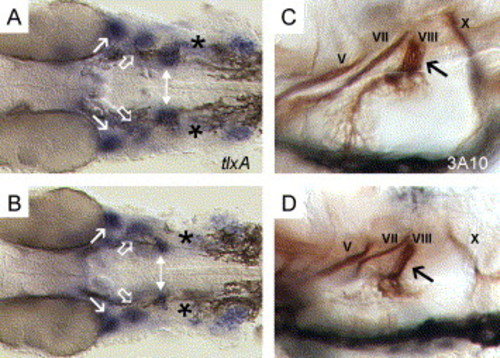Fig. 8
- ID
- ZDB-FIG-050124-4
- Publication
- Kozlowski et al., 2005 - The zebrafish dog-eared mutation disrupts eya1, a gene required for cell survival and differentiation in the inner ear and lateral line
- Other Figures
- All Figure Page
- Back to All Figure Page
|
Statoacoustic ganglion phenotype in dogtm90b. (A and B) Expression of tlxA mRNA in wild-type sibling (A) and dogtm90b (B) embryos. Fewer tlxA-expressing cells are found in the SAg of dogtm90b (double-headed arrow, panel B) embryos when compared to wild-type siblings (A). Numbers of tlxA-expressing cells in the trigeminal (line arrow) and anterior lateral line ganglia (open arrow) are comparable in wild-type siblings and mutants. (C and D) Lateral views of axonal projections around the otocyst expressing the 3A10 epitope. In dogtm90b embryos (D), there are longer, but fewer, axonal projections in the VIIIth nerve (black arrow). (A and B) Ventral view, anterior to left. (C and D) Dorsal to top and anterior to left. Asterisks mark the otic vesicles. |
| Gene: | |
|---|---|
| Fish: | |
| Anatomical Term: | |
| Stage: | Day 4 |
Reprinted from Developmental Biology, 277(1), Kozlowski, D.J., Whitfield, T.T., Hukriede, N.A., Lam, W.K., and Weinberg, E.S., The zebrafish dog-eared mutation disrupts eya1, a gene required for cell survival and differentiation in the inner ear and lateral line, 27-41, Copyright (2005) with permission from Elsevier. Full text @ Dev. Biol.

